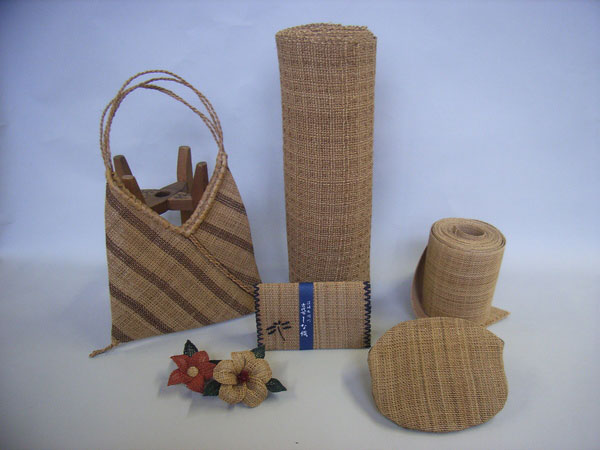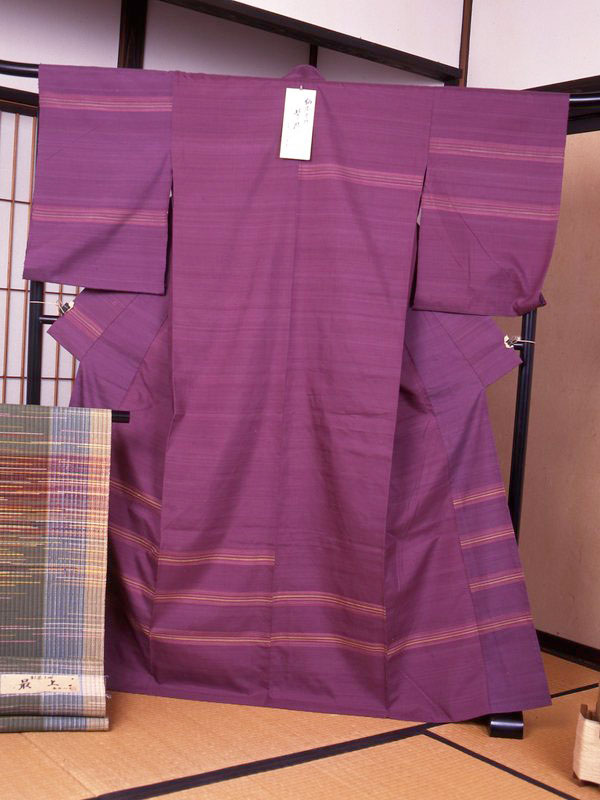
- Woven textiles
- Yamagata
Uetsu tilia bark cloth Uetsu shinafu
One of the three major ancient woven textiles in Japan
All four seasons are spent producing each piece
Description
What is Uetsu tilia bark cloth ?
Uetsu Shinafu is a textile produced in the area of Sekikawa, Tsuruoka, Yamagata prefecture, and Sanpoku, Murakami, Niigata prefecture. The names of the neighboring prefectures of Yamagata (Uzen) and Niigata (Echigo) are combined and called Uetsu, hence the name of the textile. The threads are made from the bast fiber of linden, Tilia maximowicziana Shiras and Tilia noziricola Hisauti, which grow naturally on the Japan Sea side of the Tohoku region since ancient times. "Shinafu" is the textile that is woven using the threads from these trees. It is said that Uetsu Shinafu is the oldest woven textile that uses threads made from tree bark. In the old days, the woven textile was used for sacks to hold vegetables and grains, as filtering cloth, and for work clothes. Today, the textile is used for making various products for modern life, including bags, wallets, clothing accessories and tapestries. The characteristics of Uetsu Shinafu are the plain texture unique to the bast fiber, its water resistant property, and its durability. It takes a long time to weave Uetsu Shinafu. The production starts with the cutting down the linden trees during the rainy season. The bast fiber is collected from summer to autumn, the threads are made during the winter, and the textile is woven until spring. There are more than twenty steps involved to make this craft.
History

It is said that the techniques for producing textiles with the fiber made from plants or trees existed since the Jomon period (from around 14000 to 300 BC). When and how people in these regions started to make the Shinafu is not known. However, Uetsu Shinafu is considered to be one of the three major ancient woven textiles along with Bashofu in Okinawa and Kuzufu in Shizuoka. Also the fact that the word Shinafu, although it was written in different Chinese characters, was recorded in the documents written during the Heian period (794 – 1185), suggests that the textile already existed then. These textiles were produced everywhere in Japan in ancient times but gradually disappeared as cotton and silk fabrics, as well as artificial fabrics, replaced them after the second World War. Shinafu was processed to make local crafts in the latter half of the Showa period (1926-1989), and the good quality of Shinafu was appreciated again. The Shina Ori Center was established in the area of Sekikawa, Tsuruoka City after 1985 and the whole region has been collaborating to keep producing Shinafu since then.
General Production Process
- 1. Peeling the tree bark
Linden trees are cut down during the rainy season from the middle of June to the beginning of July. The branches are cut off, the tree bark is peeled off, and the bast fiber inside of the bark is taken out.
- 2. Drying
The bast fiber is thoroughly dried in the sun for about seven days in mid July and stored in a dry place, for example, a loft, until the boiling process.
- 3. Soaking
The bast fiber is soaked in a pond or river to soften it for about two days before the boiling, which is carried out in August.
- 4. Winding the bast fiber
The bast fiber is taken out of the water, wound into a cross-shape and tied so that it can be boiled in a pot.
- 5. Boiling
A large pot is placed on a stove made of red clay and the wound bast fiber is placed in the pot to be boiled with wood ashes in water for approximately 10 to 12 hours.
- 6. Peeling the bast fiber
The bast fiber is taken out of the large pot after being boiled. It is washed lightly in water and kneaded well by hand. Then, the bast fiber is peeled layer by layer.
- 7. Scrubbing
In late August, the bast fiber is taken to the river and scrubbed in water in the direction of the stream, using stones or bamboo sticks. After this process, only the fiber that will become threads remains.
- 8. Soaking the fiber
In September, the fiber which is wound into a skein is put into a large tub and soaked in water with rice bran for two days and two nights. After that, the rice bran is washed away in the river.
- 9. Drying the fiber
The washed fiber is hung in front of the house to dry.
- 10. Shredding
The fiber is moistened and shredded with the fingers into threads. After the fiber is shredded, the threads are bundled and dried again. This process is usually done around the time snow starts to fall.
- 11. Joining the shredded threads
This is a process to join the shredded fibers into long threads. A small hole is made at the joint part of the fiber to make a small ring. Another shredded fiber is inserted into the ring part and twisted to make one long thread. This requires much experience and skills.
- 12. Winding the joined threads
The threads are wound into a ball to make the next process easier.
- 13.Twisting the threads
To make the threads stronger and better, the threads are twisted using a spinning wheel. This is the final process in making the threads.
- 14. Reeling the threads
A wooden reel is placed on the stand called the uttate. The threads are reeled by turning the handle of the stand. This is done around the middle of December.
- 15. Warping
The threads are prepared for the loom. The threads are set on the warping stand to make the warp threads and the other threads are set on a tool called kuda to make the weft threads.
- 16. Winding the threads on the core of the loom
The threads are wound around the core of the loom with paper called hatakusa in between.
- 17. Putting the threads through the heddle
The heddle is the part of the loom which has thin wires lined vertically in a square frame. Each of the wires has a small hole and the warp threads are put through this hole in each wire.
- 18. Putting the threads through the reed
The threads that have been put through the heddle are then put through the reed, which is fixed in the front part of the loom.
- 19. Tying to the oritsuke nuno
When the warp threads are set on the loom, it is ready for weaving. A cloth called oritsuke nuno is wound around the stick to roll the woven textile and the warp threads are are tied to the oritsuke nuno.
- 20. Winding the weft threads around the kuda
The weft threads are wound around a spool called kuda. After the threads have been wound around it, the kuda is set in the shuttle.
- 21. Weaving
The weaver starts weaving around the middle of March. The looms used for weaving are either the izari loom which is an old and orthodox type of loom, or the takahata loom which is a traditional treadle-operated tall loom. It takes four seasons to complete the production of Uetsu Shinafu.
See more Woven textiles
- Nishijin brocade
- Yuki tsumugi silk
- Kurume traditional resist-dyed textiles
- Ojiya chijimi textiles
- Hakata brocade
- Ushikubi tsumugi silk
- Chichibu-meisen silk
- Miyako ramie textile
- Shiozawa tsumugi silk
- Kumejima tsumugi silk
- Omi ramie cloth
- Ryukyu traditional resist-dyed textiles
- Kiryu brocade
- Murayama-oshima tsumugi silk
- Yumihama traditional resist-dyed textiles
- Chibana-hanaori textiles
- Hon-shiozawa silk
- Oitama tsumugi silk
- Ojiya tsumugi silk
- Yaeyama cotton cloth
- Yaeyama ramie cloth
- Honba oshima tsumugi silk
- Shinshu tsumugi silk
- Shuri brocade
- Tama brocade
- Yomitanzan-hanaori textiles
- Isesaki traditional resist-dyed textiles
- Hachio island silk
- Nibutani bark cloth
- Uetsu tilia bark cloth
- Awa-shijira cotton cloth
- Kijoka banana fiber cloth
- Tokamachi traditional resist-dyed textiles
- Tokamachi akashi chijimi textiles
- Yonaguni brocade
- Yuntanza minsa
- Flower pattern textiles
- Oku-Aizu Showa Karamushi Textiles































































































































































































































































































